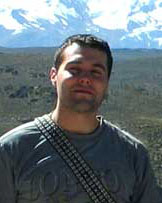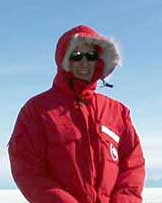Nevado Firura Glacier, Peru
This Project is supported by a generous grant from the
Dan and Betty Churchill Exploration Fund
June 15, 2005 to July 14, 2005


20th June - Capilla to Nevado Firura
Gordon writes:
20th June: I have been warned repeatedly about eating dodgy food whilst in Peru, so I have been quite paranoid about what I consume. It does get rather tiring, however, having to remove every last bit of salad from a dish for fear of the consequences. No trouble as of yet, though I’m still waiting to see what that tepid papas rellenas I had for breakfast has in store for me! The drive is a long one, from Arequipa to Capilla, and takes us through the lower reaches of the Rio Majes before shuttling us up to 4,300 m. The scenery here is stunning and typically arid, though down in the bottom of the canyon isolated towns are sustained by the river and the green of irrigated land sticks out like a sore thumb.
Up on the plateau it is the snow-capped Nevado Coropuna, the highest volcano in Peru, that dominates the view. Our route took us right underneath it and past textbook landforms of glacial erosion, as well as past some sections of the Inca road. Herds of llama graze this landscape and up close they have very peculiar facial expressions, not to mention red earrings! At this height it gets very cold at night and so I’ve been noticing huge patches of ice lying in the streams and outwash plains. It’s also high enough for us lowlanders to feel a little feeble when moving around, though that should diminish with time. More than anything, it is just a really good feeling to be out of the city and entering our field area.
Capilla is a small, seasonal village in which the herders and their families live during the winter. In summer, when the snow comes, they move to lower elevations. This may seem backwards, but in the Andes the temperature difference between daytime and night time is greater then the temperature difference between winter and summer. We are having highs in the 60s-70s°F and nightly lows around 10°F. The southern hemisphere summer (December to March) is the wet time of the year, which in the highlands means lots of snow on the ground. So highland archaeology and geology is done in the southern hemisphere winter (June to August) when it is the driest time of year there. The Andean pastoral pattern (and the seasonal occupation of high elevation towns) is structured around precipitation since, winter or summer, the temperature will be pretty much the same.
When we pulled in at sunset I remember thinking how desolate it appeared, and deserted, but soon enough a figure appeared from a small house and informed us we could camp in the abandoned churchyard. This was our first night camping and so spirits were high. It was also, however, the first night that I realised how early it gets dark in the tropics. At 6 pm it is both dark and cold, and to top that we each had persistent headaches from the altitude.
For further information, see the project page.

